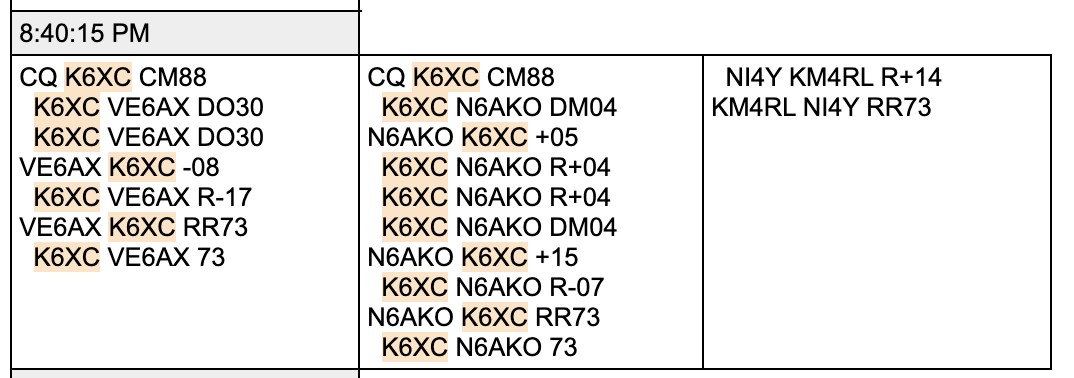The highly efficient digital radio protocol called FT8 gets much of its efficiency by limiting in messages what can be said and when. Still within this framework exists sufficient latitude for humans to engage in a collective activity a bit like trading stamps.
I will explain two conversations overhead between three stations made interesting in how the operators took turns.
First the rules. Then my interpretation.
Stations take turns transmitting at 15 second intervals always starting at 00, 15, 30 or 45 seconds into the minute.
Stations announce the intended recipient of each message and their own identity using internationally assigned callsigns, letters and numbers as national prefix, then more letters for the specific station.
Accepted abbreviations include CQ for calling anyone, letter letter number number for geographic location, a positive or negative signal report in decibels above or below the noise, R to acknowledge info received and 73 for good by and best regards.

The two conversations of interest start at 8:40:15 when the VE and the N6 both respond to the K6's broadcast invitation. Already everyone has announced their callsigns and geographic locations.
I've highlighted the K6 to help keep track.
first N6
K6 will see both responses. He picks the stronger N6 and responds +05. The VE repeats his call, waiting his turn.
Note: Transmissions on odd seconds are indented in this printout. When you see two indents following each other that just means the expected response didn't appear.
then VE
K6 then turns his attention to the VE who has repeated his initial response. He tells VE that is signal is -08, not so strong but easily decoded.
VE acknowledges the signal report and returns -17 back. A -17 is weak but workable. Signals at -23 can work.
K6 and VE close with acknowledgments and pleasantries.
N6 has been waiting repeating his R+04. With no immediate response he backs up the sequence to repeat his initial call.
back to N6
K6 is now ready to continue with N6 and gives him an improved +15 report. K6 backed up because N6 did and thus they are back in sync.
N6 acknowledges and sends his revised report -07. The path is weakening for N6 even while it improves for K6.
Note: The ionosphere tends to reflect equally both ways but these measurements are relative to local noise at each end which can be quite different and changing.
K6 sends RR acknowledging both R received and the revised report. He adds 73 winding up his part.
N6 offers his 73 best regards as a final courtesy.
.
See Making the Exchange Script about collecting and displaying this data.